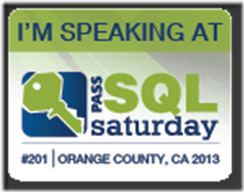I will be speaking on both Friday and Saturday (April 19-20) at SQLSaturday #201 in Orange County, California. I will be delivering a full day pre-con on Friday, and then doing both Hardware 201 and Dr. DMV on Saturday. Here is the abstract for my pre-con:
Scaling SQL Server 2012
How can you scale SQL Server 2012? Scaling up is relatively easy (but can be expensive), while scaling out requires significant engineering time and effort. If you suggest hardware upgrades you may be accused of simply “throwing hardware at the problem”, and if you try to scale out, you may be thwarted by a lack of development resources or 3rd party software restrictions. As your database server nears its load capacity, what can you do? This session gives you concrete, practical advice on how to deal with this situation. Starting with your present workload, configuration and hardware, we will explore how to find and alleviate bottlenecks, whether they are workload related, configuration related, or hardware related. Next, we will cover how you can decide whether you should scale up or scale out your data tier. Once that decision is made, you will learn how to scale up properly, with nearly zero down-time. If you decide to scale out, you will learn about practical, production-ready techniques such as vertical partitioning, horizontal partitioning, and data dependent routing. We will also cover how to use middle-tier caching and other application techniques to increase your overall scalability.
You can register for my pre-con here.
Here are the sessions that I will present on Saturday:
Hardware 201: Selecting Database Hardware
The foundation of database performance is the underlying server hardware and storage subsystem. Even the best designed and optimized database application can be crippled by an inadequate hardware and storage infrastructure. Recent advances in new processors and chipsets, along with improvements in magnetic and SSD storage have dramatically changed the evaluation and selection process compared to the past. Many database professionals struggle to keep up with new technology and often simply let someone else make their hardware selection and sizing decisions. Don’t let this happen to you! This session covers current and upcoming hardware from both Intel and AMD.
Dr. DMV: How to Use Dynamic Management Views
SQL Server 2005 introduced Dynamic Management Views (DMVs) that allow you to see exactly what is happening inside your SQL Server instances and databases with much more detail than ever before. SQL Server 2008 R2 adds even more capability in this area. You can discover your top wait types, most CPU intensive stored procedures, find missing indexes, and identify unused indexes, to name just a few examples. This session (which is applicable to SQL Server 2005 through 2012), presents and explains over fifty DMV queries that you can quickly and easily use to detect and diagnose performance issues in your environment.
I actually went to college at U.C. Irvine, and I spent several years living in the area later. I hope to see a lot of people at this event!

